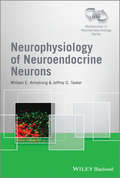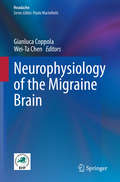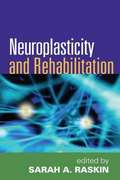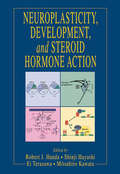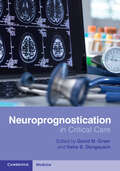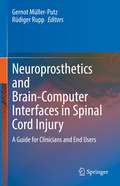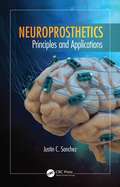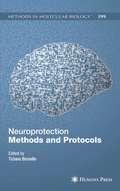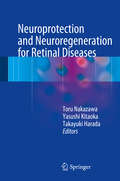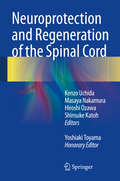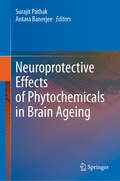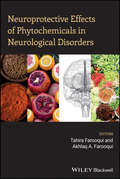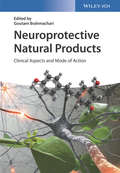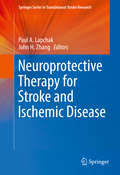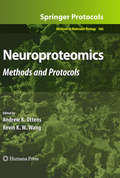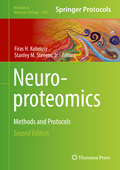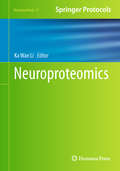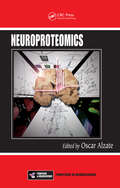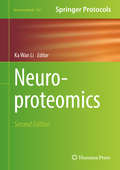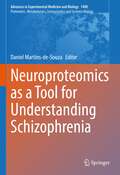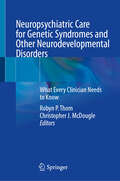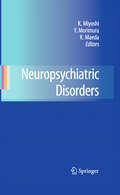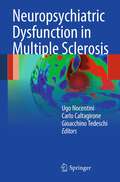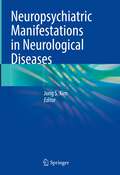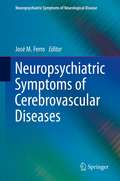- Table View
- List View
Neurophysiology of Neuroendocrine Neurons
by Jeffrey G. Tasker William E. ArmstrongNeurophysiology of Neuroendocrine Neurons provides researchers and students with not only an understanding of neuroendocrine cell electrophysiology, but also an appreciation of how this model system affords access to virtually all parts of the neuron for detailed study - something unique compared to most types of neuron in the brain. Chapters range from those describing the rich history and current state of in vivo recordings, highlighting the precise relationship between the patterns of action potential discharge in these neurons and hormone release, to in vitro approaches where neuroendocrine neurons can be precisely identified and their membrane properties, morphology, and synaptic responses, directly examined. * Written by a team of internationally renowned researchers, each chapter presents a succinct summary of the very latest developments in the field* Includes an evaluation of different experimental approaches, both in vivo and in vitro, and how the resulting data are interpreted* Both print and enhanced e-book versions are available* Illustrated in full colour throughoutThis is the first volume in a new Series 'Masterclass in Neuroendocrinology' , a co- publication between Wiley and the INF (International Neuroendocrine Federation) that aims to illustrate highest standards and encourage the use of the latest technologies in basic and clinical research and hopes to provide inspiration for further exploration into the exciting field of neuroendocrinology.
Neurophysiology of the Migraine Brain (Headache)
by Gianluca Coppola Wei-Ta ChenRoughly one in every five patients referred to a neurologist suffers from headaches; the majority have migraines. Although headache specialists understand migraine on a clinical basis, the pathophysiological changes that provoke and accompany the development of a migraine attack continue to elude us. Several decades have passed since the pioneering electroencephalographic study by Golla and Winter (1959), which underscored the role of abnormal rhythmic activities in migraine. Since then, there have been substantial advances in the field; a wealth of neurophysiological studies has enriched our understanding of the pathophysiological facets of the migraine pathology. Virtually every known technique of clinical electrophysiology has since been used to study the migraine brain and, more recently, new neurophysiological tools have been added to the arsenal. Nevertheless, applying the principles of peripheral and central neuromodulation offers a promising way to transfer the principles of synaptic plasticity to the patient’s bedside. This book belongs to the Headache Series endorsed by the European Headache Federation. Written by internationally recognized experts in their respective fields, it covers all aspects of clinical neurophysiological methods that represent significant advances in our understanding of the pathophysiology of migraine. It will offer a valuable toolkit for beginners, and a reference guide for experts.
Neuroplasticity and Rehabilitation
by Sarah RaskinBrain plasticity is the focus of a growing body of research with significant implications for neurorehabilitation. This state-of-the-art volume explores ways in which brain-injured individuals may be helped not only to compensate for their loss of cognitive abilities, but also possibly to restore those abilities. Expert contributors examine the extent to which damaged cortical regions can actually recover and resume previous functions, as well as how intact regions are recruited to take on tasks once mediated by the damaged region. Evidence-based rehabilitation approaches are reviewed for a range of impairments and clinical populations, including both children and adults.
Neuroplasticity, Development, and Steroid Hormone Action
by Robert J. Handa Shinji Hayashi Ei Terasawa Mitsuhiro KawataA compilation of cutting-edge research, Neuroplasticity, Development, and Steroid Hormone Action explores the effects of steroid hormones on brain development, function, and aging. The experimental approaches used by the authors ranges from molecular to behavioral and endocrine to neurobiological. It contains scientific photographs, line drawings, tables, color illustrations, and graphs, this interesting and timely text covers the neuroplastic effects of steroid hormones throughout the lifetime of various animal models, such as bees, fish, lizards, turtles, birds, mice, rats, and primates.
Neuroprognostication in Critical Care
by David M. Greer Neha S. DangayachNeuroprognostication in patients with primary neurological diagnoses as well as in critically ill patients with concomitant neurological diagnoses is increasingly complex. With advances in critical care, the focus of the field is progressively moving from survivorship to improving patients' quality of life. This evidence-based resource provides an in-depth analysis of different aspects of prognostication in neurologically critically ill patients, covering how to gather the correct data and synthesize this information at the bedside. Delving into disease specific prognostication such as traumatic brain injury, acute ischemic stroke and delirium, guidance is provided for choosing management strategies based on overall perception of prognostication and shared decision making. Other topics covered include religious and legal issues, palliative care, chronic critical illness and new frontiers including machine learning and biomarkers usage. An online version of the book with expandable figures can be accessed on Cambridge Core, via the code printed inside the cover.
Neuroprosthetics and Brain-Computer Interfaces in Spinal Cord Injury: A Guide for Clinicians and End Users
by Gernot Müller-Putz Rüdiger RuppThis book provides a comprehensive overview of the current state of the art of practical applications of neuroprosthesis based on functional electrical stimulation for restoration of motor functions lost by spinal cord injury and discusses the use of brain-computer interfaces for their control.The book covers numerous topics starting with basics about spinal cord injury, electrical stimulation, electrical brain signals and brain-computer interfaces. It continues with an overview of neuroprosthetic solutions for different purposes and non-invasive and invasive brain-computer interface implementations and presents clinical use cases and practical applications of BCIs. Finally, the authors give an outlook on cutting edge research with a high potential for clinical translation in the near future.All authors committed themselves to use easy-to-understand language and to avoid very specific information, focusing instead on the essential aspects. This makes this book an ideal choice not only for researchers and clinicians at all stages of their education interested in the topic of brain-computer interface-controlled neuroprostheses, but also for end users and their caregivers who want to inform themselves about the current technological possibilities to improve paralyzed motor functions.
Neuroprosthetics: Principles and Applications (Rehabilitation Science in Practice Series)
by Justin C. SanchezMaster the tools of design thinking using Neuroprosthetics: Principles and Applications. Developed from successfully tested material used in an undergraduate and graduate level course taught to biomedical engineering and neuroscience students, this book focuses on the use of direct neural sensing and stimulation as a therapeutic intervention for complex disorders of the brain. It covers the theory and applications behind neuroprosthetics and explores how neuroprosthetic design thinking can enhance value for users of a direct neural interface. The book explains the fundamentals of design thinking, introduces essential concepts from neuroscience and engineering illustrating the major components of neuroprosthetics, and presents practical applications. In addition to describing the approach of design thinking (based on facts about the user’s needs, desires, habits, attitudes, and experiences with neuroprosthetics), it also examines how effectively "human centered" neuroprosthetics can address people’s needs and interactions in their daily lives. Identifying concepts and features of devices that work well with users of a direct neural interface, this book: Outlines the signal sensing capabilities and trade-offs for common electrode designs, and determines the most appropriate electrode for any neuroprosthetic application Specifies neurosurgical techniques and how electronics should be tailored to capture neural signals Provides an understanding of the mechanisms of neural–electrode performance and information contained in neural signals Provides understanding of neural decoding in neuroprosthetic applications Describes the strategies that can be used to promote long-term therapeutic interventions for humans through the use of neuroprosthetics The first true primary text for undergraduate and graduate students in departments of neuroscience and bioengineering that covers the theory and applications behind this science, Neuroprosthetics: Principles and Applications provides the fundamental knowledge needed to understand how electrodes translate neural activity into signals that are useable by machines and enables readers to master the tools of design thinking and apply them to any neuroprosthetic application.
Neuroprotection Methods and Protocols
by Tiziana BorselloThis book examines current research into the role of neuronal death in cell signaling pathways, and its role in neurodegenerative diseases, such as Alzheimer's and Parkinson's. After introducing neurodegenerative, traumatic, and ishemic disorders, the authors cover in vitro and animal systems, and cellular and molecular mechanisms.
Neuroprotection and Neuroregeneration for Retinal Diseases
by Toru Nakazawa Yasushi Kitaoka Takayuki HaradaThis book provides the latest findings on neuroprotection and neuroregeneration as potential therapeutic strategies for various eye diseases, namely, glaucoma, age-related macular degeneration (AMD), retinal detachment, and retinitis pigmentosa. Glaucoma is one of the main causes of blindness throughout the world, and other diseases such as AMD and retinitis pigmentosa also lead to loss of vision. All these conditions are characterized by degeneration of specific retinal cell types, making it essential to establish treatments to protect retinal neurons and the optic nerve. With that aim in mind, this book explains the mechanisms underlying aforementioned diseases and their experimental models. The novel strategy proposals for the treatment of retinal diseases based on the concept of neuroprotection are also discussed in the main body of the text, while the section on regenerative research discusses optic nerve regeneration, endothelial progenitor cells, and iPS cells. This book is recommended as a professional reference work for all doctors and trainees in the field of ophthalmology who are interested in neuroprotective and neuroregenerative treatments.
Neuroprotection and Regeneration of the Spinal Cord
by Kenzo Uchida Masaya Nakamura Hiroshi Ozawa Shinsuke Katoh Yoshiaki ToyamaNeuroprotection and Regeneration of the Spinal Cord comprehensively covers the most recent research in the field of spinal cord injury. The first part of this book focuses on the latest animal models and clinically oriented work, providing extensive information on morphological factors and, biomechanical analysis, in addition to the mechanism of functional recovery. The book goes on to provide information on clinical relevance introducing analysis of spinal cord injuries using MRI and PET. Edited by renowned experts in the field, this book will provide clinical physicians, basic researchers and postgraduate students with valuable insight into the cutting-edge research and progress in the field of spinal cord injury, treatment and repair.
Neuroprotective Effects of Phytochemicals in Brain Ageing
by Surajit Pathak Antara BanerjeeThis book discusses the mechanism and therapeutic strategies of phytochemicals against brain ageing. It discusses the underlying anti-oxidative and anti-inflammatory mechanisms of the phytochemicals and the implications of these compounds in the prevention and treatment of geriatric diseases. It discusses the potential role of the highly complex interactive network between the gut and the brain in neurodegenerative diseases such as Parkinson’s disease (PD), and Alzheimer’s disease. The chapters provide insight into the mechanisms involved in brain ageing and the mechanism of actions of the phytochemicals that might be crucial in developing effective new therapies against brain ageing. The chapter also presents the mechanisms of action of phytoconstituents, bioavailabilities, and their effects on neuroinflammation. The chapters also examine the phytochemicals protection of neurons via targeting oxidative stress, mitochondrial dysfunction, neurotrophic factor deficit, apoptosis, and abnormal protein accumulation. This book aims to provide comprehensive and cutting-edge information on the potential neuroprotective role of phytochemicals on the brain and neurological disorders to researchers, neuroscientists, clinical nutritionists, and physicians.
Neuroprotective Effects of Phytochemicals in Neurological Disorders
by Akhlaq A. Farooqui Tahira FarooquiPhytochemicals are naturally occurring bioactive compounds found in edible fruits, plants, vegetables, and herbs. Unlike vitamins and minerals, phytochemicals are not needed for the maintenance of cell viability, but they play a vital role in protecting neural cells from inflammation and oxidative stress associated with normal aging and acute and chronic age-related brain diseases. Neuroprotective Effects of Phytochemicals in Neurological Disorders explores the advances in our understanding of the potential neuroprotective benefits that these naturally occurring chemicals contain. Neuroprotective Effects of Phytochemicals in Neurological Disorders explores the role that a number of plant-based chemical compounds play in a wide variety of neurological disorders. Chapters explore the impact of phytochemicals on neurotraumatic disorders, such as stroke and spinal cord injury, alongside neurodegenerative diseases such as Alzheimer's and Parkinson's Disease, as well as neuropsychiatric disorders such as depression and schizophrenia. The chapters and sections of this book provide the reader with a big picture view of this field of research. Neuroprotective Effects of Phytochemicals in Neurological Disorders aims to present readers with a comprehensive and cutting edge look at the effects of phytochemicals on the brain and neurological disorders in a manner useful to researchers, neuroscientists, clinical nutritionists, and physicians.
Neuroprotective Natural Products: Clinical Aspects and Mode of Action
by Goutam BrahmachariFocusing on the molecular mechanisms of powerful naturally occurring agents and their implication for drug discovery, this timely book presents an overview of the most recent research advances in the field of bioactive natural products and natural drug formulations to combat today's destructive diseases. To this extent, the authors discuss the most severe neurological disorders in our modern civilization, such as Alzheimer's, Parkinson's and Huntington's disease, as well as ischemic brain stroke and depression. The emerging diversity of active compounds is covered in detail, including flavonoids, cannabinoids and oleanolic acid, while experts in the field explain the chemistry, mode of action and clinical aspects of novel neuroprotective natural products. In each case, the benefits of treatments using natural products are addressed from the perspective of modern as well as traditional medicine. With its multidisciplinary viewpoint, this is the ideal companion for medicinal and natural products chemists as well as neuroscientists, biochemists, pharmacologists, neurobiologists, and phytotherapists.
Neuroprotective Therapy for Stroke and Ischemic Disease
by Paul A. Lapchak John H. ZhangA critical and comprehensive look at current state-of-the-art scientific and translational research being conducted internationally, in academia and industry, to address new ways to provide effective treatment to victims of ischemic and hemorrhagic stroke and other ischemic diseases. Currently stroke can be successfully treated through the administration of a thrombolytic, but the therapeutic window is short and many patients are not able to receive treatment. Only about 30% of patients are "cured" by available treatments. In 5 sections, the proposed volume will explore historical and novel neuroprotection mechanisms and targets, new and combination therapies, as well as clinical trial design for some of the recent bench-side research.
Neuroproteomics
by Andrew K. Ottens Kevin K.W. WangWith the development of polypeptide ionization processes for mass spectrometry and the rapid processing of large-scale datasets with bioinformatics, researchers now have the tools necessary to propel neuroproteomics research to new levels. In Neuroproteomics: Methods and Protocols, experts in the neurological and analytical sciences present experimental details for applying proteomics to the study of the central nervous system (CNS) and its dysfunction through trauma and disease. Divided into four convenient sections, this collection covers CNS animal models used for neuroproteomics research, methods for separating and analyzing discrete subcomponents of the neuroproteome, large-scale approaches for CNS proteome characterization and quantification, as well as methods that evaluate biofluids and translate neuroproteomic results into clinical platforms. As a volume in the highly successful Methods in Molecular BiologyTM series, chapters include brief introductions to their respective topics, lists of the necessary materials and reagents, step-by-step, readily reproducible laboratory protocols, and notes on troubleshooting and avoiding known pitfalls. Authoritative and cutting-edge, Neuroproteomics: Methods and Protocols includes the clear "how-to" information needed to critically assess what can be accomplished in the field and how to best perform and evaluate neuroproteomic experiments in one's own research.
Neuroproteomics
by Jr. Firas H. Kobeissy Stanley M. StevensThis new edition provides updated and novel protocols of neuroproteomics methods that encompass both global-scale as well as targeted and specialized topics, which are timely additions for the molecular and phenotypic analysis of the central nervous system and CNS-related disorders. The detailed contents of this book include the exploration of several exciting areas of advanced methods used for neuroproteomics research including relative and absolute protein quantitation by mass spectrometry, characterization of post-translational modifications, as well as bioinformatics and computational approaches. Written for the highly successful Methods in Molecular Biology series, methodology chapters include introductions to their respective topics, lists of the necessary materials and reagents, step-by-step, readily reproducible protocols, and tips on troubleshooting and avoiding known pitfalls. Updated and accessible, Neuroproteomics: Methods and Protocols, Second Edition serves researchers and clinical scientists involved in the area of biomarker research and protein biochemistry, as well as molecular biologists and biochemists who have been involved in proteomics research already or even for those new to the field.
Neuroproteomics
by Ka Wan LiIn the past few years, the application of proteomics to examine the molecular mechanisms underlying (mal-)functioning of the nervous system and brain disorders has risen steeply, which in many cases has yielded novel insights. As neuroproteomics is a new research field involving the use of a number of high-end analytical instruments and technologies, both promises and pitfalls may not be well appreciated by the researchers, and the design of a proper proteomics experiment may not be obvious. Neuroproteomics brings together a collection of detailed protocols written by experienced professionals in the field in order to cover aspects of various dimensions of this new technology, together with some established methods that have supporting roles in the workflow of neuroproteomics. Written for the popular Neuromethods series, the chapters in this book contain step-by-step, easy to follow instruction along with practical tips and key implementation advice essential for successful implementation of the techniques. Authoritative and cutting-edge, Neuroproteomics will be of great assistance to all researchers seeking to design and execute their own proteomics experiments in an optimal way and continue moving forward this exciting area of study.
Neuroproteomics
by Oscar AlzateIn this, the post-genomic age, our knowledge of biological systems continues to expand and progress. As the research becomes more focused, so too does the data. Genomic research progresses to proteomics and brings us to a deeper understanding of the behavior and function of protein clusters. And now proteomics gives way to neuroproteomics as we beg
Neuroproteomics (Neuromethods #146)
by Ka Wan LiThis second edition volume expands on the previous edition with updates on the latest techniques used in the field of proteomics. Tissue and cellular proteins are now being analyzed at near proteome-wide levels and mass spectrometers are achieving higher sensitivity and speed, resolution, and accuracy. The chapters in this book cover various new methods used in proteomic workflows such as laser microdissection for spatial proteomics of post-mortem brain tissue, sample preparation in single vessel with FASP and SP3 protocols, the crosslinking mass spectrometry, TMT-MS3 based proteomic with synchronous precursor selection, mass spectrometric data dependent acquisition (DDA) and data independent acquisition (DIA, SWATH) methods, 2D-DIGE, and MALDI Imaging Mass Spectrometry. In Neuromethods series style, chapters include the kind of detail and key advice from the specialists needed to get successful results in your laboratory.Cutting-edge and comprehensive, Neuroproteomics, Second Edition is a valuable guide that help researchers obtain the finest results from current proteomics platforms.
Neuroproteomics as a Tool for Understanding Schizophrenia (Advances in Experimental Medicine and Biology #1400)
by Daniel Martins-de-SouzaOver the past decade, neuroproteomics has shed light on the molecular features of schizophrenia by depicting biological processes involved with its establishment, maintenance and treatment. These studies have also pointed to potential biomarkers applicable to diagnosis and medication monitoring. Edited by a leader in the field of neuroproteomics with contributions from subject experts, this new volume will address recent findings and compile evidence from difference perspectives—such as human samples, animal models, pluripotent stem cell-derived in vitro pre-clinical models—and provide findings to inform the development of innovative future treatment strategies.This volume will be useful for a broad audience of researchers and professionals, including biologists, neurologists, psychiatrists, analytical chemists, and pharmacists, among others.
Neuropsychiatric Care for Genetic Syndromes and Other Neurodevelopmental Disorders: What Every Clinician Needs to Know
by Christopher J. McDougle Robyn P. ThomChildren and adults with developmental disabilities are at increased risk for experiencing behavioral problems and psychiatric comorbidities compared to the general population and several neurodevelopmental disorders are associated with certain neuropsychiatric conditions. Because of language and cognitive differences, the clinical presentation of these conditions can differ from what is seen in the general population. Furthermore, research on treatment approaches for psychiatric comorbidities in these populations is extremely limited and evidence-based treatment guidelines do not exist. This book is a collection of neurodevelopmental disorders that are frequently associated with relatively distinct and common psychiatric co-morbidities across the lifespan. Each chapter addresses a different neurodevelopmental disorder by providing an overview, symptoms of common psychiatric co-morbidities, assessment strategies, psychosocial and biological treatments, and common medical co-morbidities the clinician needs to have basic knowledge of with regards to choosing safe and appropriate pharmacotherapy. Given how relatively rare many of these syndromes are, the practicing clinician generally does not encounter a sufficient number of cases during training or clinical practice to develop comfort and expertise in each of them. Furthermore, there are no easy to access evidence-based treatment guidelines. This succinct and practical resource fills a needed gap for an overview of the most common neurodevelopmental disorders in a single resource with a clinical expert’s approach to diagnosis and management.
Neuropsychiatric Disorders
by Kiyoshi Maeda Yasushi Morimura Koho MiyoshiAround the world societies are facing growing aging populations with the concomitant increase in neuropsychiatric disorders. Neuropsychiatric disorders are organic brain diseases with psychiatric symptoms, as in Alzheimer's and Parkinson's diseases, that cause cognitive impairment, including dementia, amnesic syndrome, and personality-behavioral changes. As a clinical science, neuropsychiatry aims to explore the complex interrelationship between behavior and brain function from a variety of perspectives, including those of psychology, neurology, and psychiatry. This concise and updated monograph comprises the latest findings in the field and includes chapters on delusional symptoms, mood disorders and neurotic symptoms, cognitive impairment, behavioral and personality changes, and recently, cerebral alterations revealed in PTSD patients and in endogenous psychoses through neuroimaging and neuropathology. These findings will certainly widen the realm of neuropsychiatry going forward and will prove of great value to specialists as well as to academics and trainees in neurology, psychiatry, neuropsychology, neuroradiology, neuropathology, neurophysiology, neurochemistry, and clinical genetics. Ultimately, neuropsychiatry aims to prevent and reduce the suffering of individuals with the psychiatric symptoms of cerebral disorders.
Neuropsychiatric Dysfunction in Multiple Sclerosis
by Gioacchino Tedeschi Ugo Nocentini Carlo CaltagironeThis book provides comprehensive and up-to-date information on the neuropsychiatric disturbances that may be experienced by patients with multiple sclerosis. The first section is designed primarily to describe the general clinical aspects of multiple sclerosis, from epidemiology to assessment tools. The role of neuroimaging and especially MRI is then explained, and treatment approaches and rehabilitation strategies are described. The core section of the volume is the second, in which the various forms of neuropsychiatric dysfunction are considered in depth. Especially, detailed attention is devoted to depression, but the other main categories of disturbance are also described and discussed. The final section addresses cognitive dysfunctions since they represent some of the worst events that patients with multiple sclerosis can suffer and are intimately related to neuropsychiatric dysfunction.
Neuropsychiatric Manifestations in Neurological Diseases
by Jong S. KimPsychiatric symptoms (or mood/emotional disturbances) are diverse in patients with neurological diseases, that include depression, anxiety, emotional incontinence, anger, fatigue, and apathy. These symptoms are common; more than 1/3 of the patients suffer from these symptoms. Unfortunately, they have been neglected because 1) unlike other neurological symptoms such as motor dysfunction, speech disturbances or visual field defect, these symptoms are not visible and difficult to be noticed unless they are specifically examined by a physician who is properly educated on this problem 2) they are often not regarded as neurological symptoms either by the patients or their caregivers 3) they are relatively poorly studied by both neurologists and psychiatrists, and accordingly, are unfamiliar to the physicians. Especially, although `depression’ is well known to physicians, other symptoms such as emotional incontinence, anger, fatigue or apathy are not appropriately assessed by physicians, and frequently misdiagnosed as depression. Moreover, there are difficulties in diagnosing depression in patients neurological diseases. For example, the individual items included in depression diagnosis such as sleep disturbances, appetite loss, or fatigue can result from neurological diseases or comorbid physical conditions in patients with neurological diseases. Therefore, a diagnosis of `depression’ should be made cautiously. Finally, it should be understood that the importance of different mood/ emotional syndromes differ among various neurological diseases; for instance, although emotional incontinence and anger occur in as many as 20-30 % of stroke patients, apathy and fatigue are more important symptoms than these for patients with neuro-degenerative disease.In clinical practice, recognizing these symptoms is important because they negatively affect the patients’ quality of life, impair the functional recovery, increase the mortality, and increase the caregiver burden. Nevertheless, unlike other neurological symptoms such as motor/sensory dysfunction, and speech disturbances, they are relatively well managed mostly by pharmacological therapy such as selective serotonin re-uptake inhibitors (SSRI).The phenomenology of these neuropsychiatric symptoms and related factors, pathophysiological mechanism, and treatment strategies should be properly educated for neurologists, psychiatrists and other physicians. The book is written by experts in this field to disseminate important knowledges to neurologists, psychiatrists, psychologists and other physicians and will eventually benefit patients with neurological diseases.
Neuropsychiatric Symptoms of Cerebrovascular Diseases
by José M. FerroNeuropsychiatric Symptoms of Cerebrovascular Diseases is an up-to-date, comprehensive review of the neuropsychiatry of stroke, by active authorities in the field, with an emphasis on diagnostic and management issues. Neuropsychiatric Symptoms of Cerebrovascular Diseases includes critical appraisal of the methodological aspects and limitations of the current research on the neuropsychiatry of stroke and on unanswered questions/controversies. Pharmacological aspects of management are discussed, to provide robust information on drug dosages, side effects and interaction, in order to enable the reader to manage these patients more safely. Illustrative cases provide real life scenarios that are clinically relevant and engaging to read. Neuropsychiatric Symptoms of Cerebrovascular Diseases is aimed at neurologists, stroke physicians and psychiatrists, and will also be of interest to intensive care doctors, psychologists ad neuropsychologists, research and specialist nurses, clinical researchers and methodologists.
